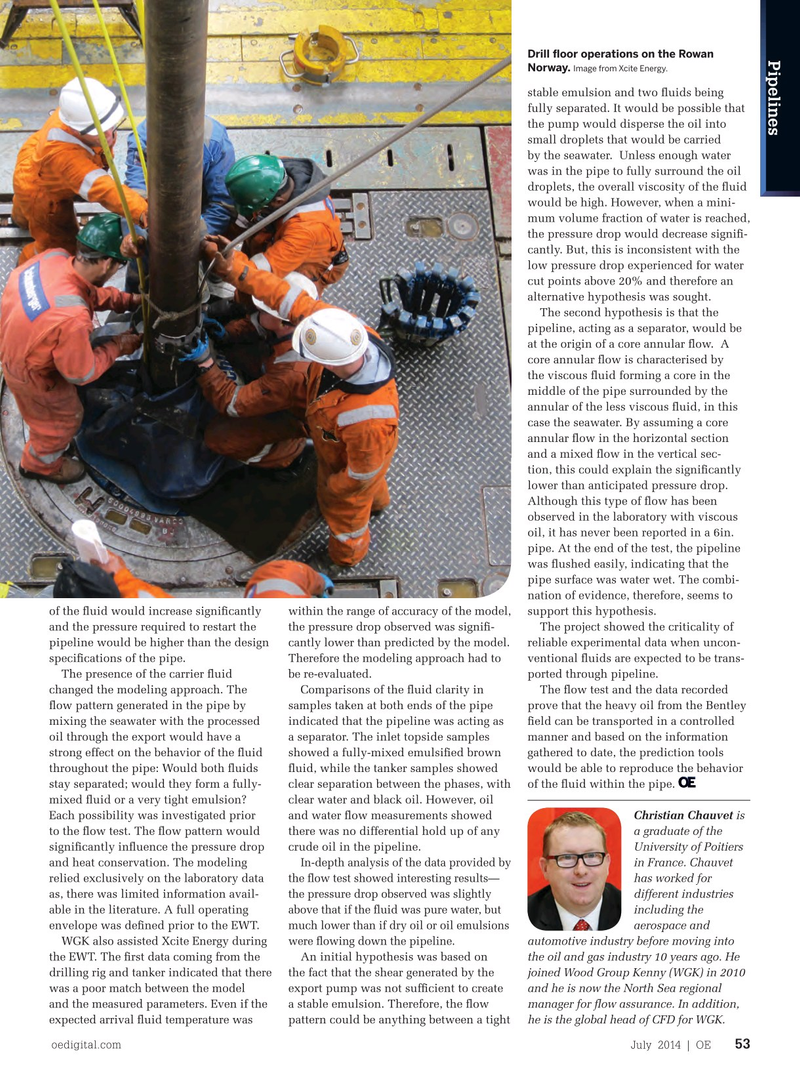
Page 51: of Offshore Engineer Magazine (Jul/Aug 2014)
Read this page in Pdf, Flash or Html5 edition of Jul/Aug 2014 Offshore Engineer Magazine
Drill ? oor operations on the Rowan
Pipelines
Norway. Image from Xcite Energy.
stable emulsion and two ? uids being fully separated. It would be possible that the pump would disperse the oil into small droplets that would be carried by the seawater. Unless enough water was in the pipe to fully surround the oil droplets, the overall viscosity of the ? uid would be high. However, when a mini- mum volume fraction of water is reached, the pressure drop would decrease signi? - cantly. But, this is inconsistent with the low pressure drop experienced for water cut points above 20% and therefore an alternative hypothesis was sought.
The second hypothesis is that the pipeline, acting as a separator, would be at the origin of a core annular ? ow. A core annular ? ow is characterised by the viscous ? uid forming a core in the middle of the pipe surrounded by the annular of the less viscous ? uid, in this case the seawater. By assuming a core annular ? ow in the horizontal section and a mixed ? ow in the vertical sec- tion, this could explain the signi? cantly lower than anticipated pressure drop.
Although this type of ? ow has been observed in the laboratory with viscous oil, it has never been reported in a 6in. pipe. At the end of the test, the pipeline was ? ushed easily, indicating that the pipe surface was water wet. The combi- nation of evidence, therefore, seems to of the ? uid would increase signi? cantly within the range of accuracy of the model, support this hypothesis.
and the pressure required to restart the the pressure drop observed was signi? - The project showed the criticality of pipeline would be higher than the design cantly lower than predicted by the model. reliable experimental data when uncon- speci? cations of the pipe. Therefore the modeling approach had to ventional ? uids are expected to be trans-
The presence of the carrier ? uid be re-evaluated. ported through pipeline. changed the modeling approach. The Comparisons of the ? uid clarity in The ? ow test and the data recorded ? ow pattern generated in the pipe by samples taken at both ends of the pipe prove that the heavy oil from the Bentley mixing the seawater with the processed indicated that the pipeline was acting as ? eld can be transported in a controlled oil through the export would have a a separator. The inlet topside samples manner and based on the information strong effect on the behavior of the ? uid showed a fully-mixed emulsi? ed brown gathered to date, the prediction tools throughout the pipe: Would both ? uids ? uid, while the tanker samples showed would be able to reproduce the behavior stay separated; would they form a fully- clear separation between the phases, with of the ? uid within the pipe. mixed ? uid or a very tight emulsion? clear water and black oil. However, oil
Each possibility was investigated prior and water ? ow measurements showed Christian Chauvet is to the ? ow test. The ? ow pattern would there was no differential hold up of any a graduate of the signi? cantly in? uence the pressure drop crude oil in the pipeline. University of Poitiers
In-depth analysis of the data provided by and heat conservation. The modeling in France. Chauvet the ? ow test showed interesting results— relied exclusively on the laboratory data has worked for the pressure drop observed was slightly as, there was limited information avail- different industries above that if the ? uid was pure water, but able in the literature. A full operating including the much lower than if dry oil or oil emulsions envelope was de? ned prior to the EWT. aerospace and were ? owing down the pipeline.
WGK also assisted Xcite Energy during automotive industry before moving into the EWT. The ? rst data coming from the An initial hypothesis was based on the oil and gas industry 10 years ago. He drilling rig and tanker indicated that there the fact that the shear generated by the joined Wood Group Kenny (WGK) in 2010 was a poor match between the model export pump was not suf? cient to create and he is now the North Sea regional and the measured parameters. Even if the a stable emulsion. Therefore, the ? ow manager for ? ow assurance. In addition, expected arrival ? uid temperature was pattern could be anything between a tight he is the global head of CFD for WGK.
oedigital.com July 2014 | OE 53 052_OE0714_Pipelines2_Bentley.indd 53 6/20/14 7:05 PM

 50
50

 52
52